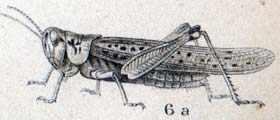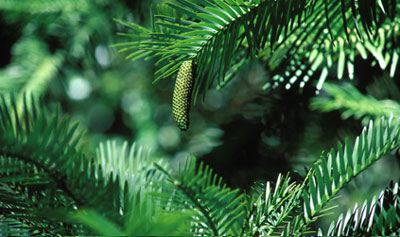A fun story from Eureka Alert!:
A scientist from the University of Manchester has discovered the first identified droplets of spider blood in a piece of amber up to 20 million years old. Two droplets of blood, technically known as haemolymph, have been preserved in the amber which also contains the spider – Filistatidae – a family commonly found in South America and the Caribbean.
The droplets are the first identified examples of spider blood ever found in an amber fossil. It is possible the blood could be used to extract DNA. The fossil, which is 4cm long and 2cm wide, was discovered in the Dominican Republic and dates back to the Miocene period.
In the latest issue of the journal Palaeontology (2005, vol. 48, part 5) David Penny describes how the spider died. He believes the spider was climbing up a tree when it was struck head-on by a sudden strong flow of resin. The spider then became engulfed in the resin and died. He argues that the shape and position of the blood droplets reveals which direction the spider was travelling in. It also reveals which of the spider's legs broke first.
David discovered the fossil in 2003 during a visit to the Museo del Ambar Dominicano in Puerto Plata, Dominican Republic. His research initially focused on the spider which he identified as an entirely new species of spider. On his return to the UK, further research revealed the droplets of blood and the information the fossil contained.
Thursday, September 29, 2005
Tuesday, September 27, 2005
Dinosaur Provincal Park Symposium Field Trip

Dinosaur Provinvial Park.

Dave Eberth explains the Park.

Phil Currie gives an introduction to bone beds at BB 50.

Don Brinkman works his mojo over some microverts collected at BB 50

Peter Dodson searches for microverts at BB 50.

Dave Eberth and Karen Chin take a break.

David Evans entertains the crowd with stories about hadrosaurs, some of which he claims are true.

RTMP Curators Dennis Braman, Dave Eberth, Don Brinkman, & Philip Currie discuss their varying ideas about Dinosaur Provincial Park
Wednesday, September 21, 2005
DINOSAUR PARK SYMPOSIUM

DINOSAUR PARK SYMPOSIUMDinosaur Provincial Park is a unique palaeontological and geological resource in Canada. Simply put, the Park is one of the richest Cretaceous-age vertebrate 'graveyards' in the world with a treasure of well-preserved dinosaurs that has made it uniquely famous in the eyes of both palaeontologists and the public.
at the ROYAL TYRRELL MUSEUM
Drumheller, Alberta
September 24-25, 2005
The primary goal of the Dinosaur Park Symposium is to bring together 250 palaeontologists, geologists, and palaeontological enthusiasts who recognize the vital role that Dinosaur Provincial Park continues to play in our understanding of the dinosaurian world. Approximately 75 contributors will offer a variety of oral and poster presentations relating to the Park, as well as related rocks and fossils from around the world. There will be a published abstract volume.
Occurring during Alberta's Centennial Year, the Dinosaur Park Symposium coincides with the Tyrrell Museum 's 20th anniversary, and the 50th anniversary of Provincial Park designation. We anticipate that the Symposium will be one of Canada 's palaeontological highlights for 2005.
Symposium events include:
- Friday evening (Sept. 23) ice-breaker at the Royal Tyrrell Museum.
- Publication of the Indiana University Press book: Dinosaur Provincial Park: A Spectacular Ancient Ecosystem Revealed, with contributions from more than 20 palaeontologists and geologists,and edited by P.J.Currie & E.B.Koppelhus.
- Keynote talks by David Spalding and Scott Sampson that will provide historical context and global perspective for the Park's resources.
- Viewing of new specimens from the Park, including the Park's newest dinosaur (compliments of Michael Ryan).
- Saturday evening (Sept. 24) BBQ at the Royal Tyrrell Museum.
- Post-symposium field trip to Dinosaur Provincial Park on Monday, September 26, 2005 (there is an additional fee for this field trip).
AAS Issues Statement Supporting Teaching of Evolution

The American Astronomical Society Council has endorsed a statement (below) supporting the teaching of evolution in K-12 schools and pointing out that so-called "Intelligent Design" is not a valid scientific theory.
A PDF version of the statement with supporting references and
links to useful supporting information is now available on the AAS
web page, www.aas.org.
American Astronomical Society Statement on the Teaching of EvolutionReference Cited:
20 September 2005
The American Astronomical Society supports teaching evolution in our nation's K-12 science classes. Evolution is a valid scientific theory for the origin of species that has been repeatedly tested and verified through observation, formulation of testable statements to explain those observations, and controlled experiments or additional observations to find out whether these ideas are right or wrong. A scientific theory is not speculation or a guess -- scientific theories are unifying concepts that explain the physical universe.
Astronomical observations show that the Universe is many billions of years old (see the AAS publication, An Ancient Universe, cited below), that nuclear reactions in stars have produced the chemical elements over time, and recent observations show that gravity has led to the formation of many planets in our Galaxy. The early history of the solar system is being explored by astronomical observation and by direct visits to solar system objects. Fossils, radiological measurements, and changes in DNA trace the growth of the tree of life on Earth. The theory of evolution, like the theories of gravity, plate tectonics, and Big Bang cosmology, explains, unifies, and predicts natural phenomena. Scientific theories provide a proven framework for improving our understanding of the world.
In recent years, advocates of "Intelligent Design," have proposed teaching "Intelligent Design" as a valid alternative theory for the history of life. Although scientists have vigorous discussions on interpretations for some aspects of evolution, there is widespread agreement on the power of natural selection to shape the emergence of new species. Even if there were no such agreement, "Intelligent Design" fails to meet the basic definition of a scientific idea: its proponents do not present testable hypotheses and do not provide evidence for their views that can be verified or duplicated by subsequent researchers.
Since "Intelligent Design" is not science, it does not belong in the science curriculum of the nation's primary and secondary schools. The AAS supports the positions taken by the National Academy of Sciences, the American Association for the Advancement of Science, the National Science Teachers' Association, the American Geophysical Union, the American Chemical Society, and the American Association of Physics Teachers on the teaching of evolution. The AAS also supports the NationalScience Education Standards: they emphasize the importance of scientific methods as well as articulating well-established scientific theories.
The Ancient Universe: How Astronomers Know the Vast Scale of Cosmic Time. Published by the American Astronomical Society. It is also available as a PDF on the Society's webpages by clicking HERE.
Image from HERE.
Frank Cho Sketchbook

I neglected to mention that Frank Cho has a wonderful sketchbook out entitled Sketches and Scribbles Book 2. This energetic collection showcases Cho's considerable talents with rough sketches & finished drawings (as well as few 'nakid girls').
Cho has been nominated for (and occasionally won) the Eisner Award, Harvey Award, The National Cartoonist Society Award, and several others.
The book comes in a signed and numbered editon by the artist from his own Monkey Boy Press (2005). Mature Readers. SC, 9x11, 80pg, b&w.
You can purchase your copy at BudPlant.com.


At The Flaming Cliffs
A variety of photos taken during our too brief visit to the famous Flaming Cliffs of Mongolia.

Phil Currie holds up a fragment of dinosaur eggshell against a backdrop of the cliffs. For scale Ito (in the photo below) is standing behind the tiny projection on the top of the cliff that is directly below Phil's thumbnail.

Ito Yoshio explores the Cliffs.

Some dramatic lighting.

Darren Tanke strikes a Roy Chapman Andrews-like pose against the Cliffs.

The Turtle Cafe located about 2 km from the Cliffs. The area has become commericalized and, in addition to the camel rides (below) being offered, one can also buy fossils collected from the region at one of several dealer tables at the top of the Cliffs.
Unfortunately there is no protection for this and other important fossil areas in Mongolia and the fossils are rapidly being stripped away by poachers. At the rate it's occurring there will be very little left to collect within a few years.

Part of our crew ride the camels.

Dr. Greg Erickson bonds with his camel.
All photos © Michael Ryan
Modern Insect Mass Extinction

From National Geographic News comes THIS ARTICLE by John Pickrell:
A new study says that the vast majority of species on the verge of extinction is in fact humble insects. The study estimates that up to 44,000 bugs of all varieties could have been wiped off the face of the Earth during the last 600 years. And hundreds of thousands more insect species could be lost over the next 50 years.Only about 70 insect extinctions have been documented since the 15th century, possibly because many insects have been poorly studied.

An 1877 U.S. federal entomologist's report included this drawing of a Rocky Mountain locust. The now extinct locust, which migrated across the U.S. plains in vast swarms, was considered by some to be the single largest barrier to westward expansion in the U.S in the 1800s."Most extinctions estimated to have occurred in the historical past, or predicted to occur in the future, are of insects," argues entomologist Robert R. Dunn of North Carolina State University in Raleigh.
Image courtesy Missouri State University
 The finding is significant, because insects play vital roles in plant pollination, decomposition, and soil processing. They also form essential links in ecological chains as plant-eaters, predators, and parasites.
The finding is significant, because insects play vital roles in plant pollination, decomposition, and soil processing. They also form essential links in ecological chains as plant-eaters, predators, and parasites. The loss of keystone insect species—those on which a large number of other species depend—could be especially detrimental for ecosystems and people. "Most entomologists I know have some species they haven't seen in years, but [they don't] have the time or money to look for them," said Dunn, who reports his findings in the current issue of the journal Conservation Biology.
Read the rest of the article HERE. Color images from HERE.
Tuesday, September 20, 2005
The Return Of Devil Dinosaur

From www.ign.com comes a preview of the new DEVIL DINOSAUR series coming out this Fall from Marvel Comics:Devil Dinosaur rules Prehistoric Earth. His ferocity is unmatched by the Small Folk and the Killer Folk. But two Celestials try to even up the odds by bringing a ferocious brute from the future back to take on Devil Dinosaur. It just so happens that this brute is the Incredible Hulk.


Brought to you by Eisner Award Winning Eric (The Goon) Powell, Marvel Monsters: Devil Dinosaur features the most savage of slugfests, the Hulk versus Devil Dinosaur. Plus, Marvel Monsters: Devil Dinosaur contains the first appearance of the Hulk from way back in November 1960 with "I Was a Slave of the Living Hulk" from Journey into Mystery #62 by Jack Kirby and Dick Ayers.
Sauropod Skulls & Dino Diversity
From the University of Michigan News Service comes this article about new research published by Dr. Jeff Wilson in the most recent issue of the Journal of Systematic Palaeontology:
ANN ARBOR, Mich. With their long necks and tails, sauropod dinosaurs famous as the Sinclair gasoline logo and Fred Flintstone's gravel pit tractor are easy to recognize, in part because they all seem to look alike.
The largest animals known to have walked the earth, sauropods were common in North America during the middle of the dinosaur era but were thought to have been pushed to extinction by more specialized plant-eaters at the end of that era. New discoveries, however, are showing that one lineage of sauropods diversified at the end of the dinosaur era, University of Michigan paleontologist Jeffrey Wilson says.

Reconstruction of the skull and lower jaw of Nemegtosaurus mongoliensis in left lateral (A), dorsal (B), posterior (C) and ventral (D) views. Illustration by Bonnie Miljour
Wilson's recent restudy and reconstruction of the skull of a Mongolian sauropod adds to a growing body of evidence for sauropod diversity at the end of the dinosaur era. Wilson described the reconstruction and the conclusions he drew from it in a paper published Aug. 24 in the Journal of Systematic Palaeontology.
He based the reconstruction on two nearly complete skulls that were found in the Gobi Desert in the 1950s and 1960s but whose evolutionary relationships have remained enigmatic. In the 1990s and early 2000s, Wilson restudied the skulls and found characteristics identifying them as skulls of titanosaurs, a late surviving sauropod lineage.
"Titanosaurs, which were surprisingly common at the end of the dinosaur era, were really the only sauropod lineage that flourished. All the others went extinct," said Wilson, an assistant professor of geological sciences and an assistant curator at the University of Michigan Museum of Paleontology. But as prevalent as titanosaurs were, they left behind surprisingly few skulls. Paleontologists have found plenty of other titanosaur bones, providing a picture of a group of sauropods with specialized limb bones.
Wilson began to appreciate the finer points of titanosaurs as a graduate student, when he and another student studied fossilized sauropod tracks and titanosaur limb anatomy. From those studies, Wilson concluded that unlike other sauropods, titanosaurs walked with their feet planted far from the middles of their bodies, an unusual style of "wide gauge" locomotion.
"Most animals walk with a narrow gauge, with their feet close to the midline, because it's energetically more efficient to walk that way. But some sauropod trackways tell us that a group of sauropods were walking with a new wide-gauge stance. We can identify characteristics of titanosaurs that would have allowed that stance, and we can tie the appearance of those features with the proliferation of wide gauge tracks everywhere in the fossil record at the end of the dinosaur era." Wilson wonders if the change in locomotion from typical sauropod narrow-gauge walking to titanosaur wide-gauge walking —corresponded to lifestyle changes, such as different feeding habits. But without skulls to study, it has been hard to draw conclusions about how and what titanosaurs ate.
With his work and that of researchers at the State University of New York, Stony Brook who announced the discovery of a complete titanosaur skeleton in 2001, sauropod specialists finally can start piecing together a clearer picture of the dinosaurs' lives.
One feature of the skulls is particularly intriguing. "They have elongate, sort of horse-like skulls with many openings and grooves on the outer surface of their snouts," said Wilson, who worked closely with U-M Museum of Paleontology artist Bonnie Miljour over the course of a year preparing the paper's many illustrations of the skull reconstruction. "Blood vessels and nerves passed through these holes and may suggest an especially sensitive snout. This probably had some role in feeding, but we haven't investigated it at all."
Oddly, a group of distantly related sauropods evolved a similarly grooved snout. "Apparently, these two different branches of sauropods gravitated toward similar anatomical structures, perhaps because they were specialized for eating certain types of vegetation."
Learn more about Jeff HERE and HERE.
ANN ARBOR, Mich. With their long necks and tails, sauropod dinosaurs famous as the Sinclair gasoline logo and Fred Flintstone's gravel pit tractor are easy to recognize, in part because they all seem to look alike.
The largest animals known to have walked the earth, sauropods were common in North America during the middle of the dinosaur era but were thought to have been pushed to extinction by more specialized plant-eaters at the end of that era. New discoveries, however, are showing that one lineage of sauropods diversified at the end of the dinosaur era, University of Michigan paleontologist Jeffrey Wilson says.

Reconstruction of the skull and lower jaw of Nemegtosaurus mongoliensis in left lateral (A), dorsal (B), posterior (C) and ventral (D) views. Illustration by Bonnie Miljour
Wilson's recent restudy and reconstruction of the skull of a Mongolian sauropod adds to a growing body of evidence for sauropod diversity at the end of the dinosaur era. Wilson described the reconstruction and the conclusions he drew from it in a paper published Aug. 24 in the Journal of Systematic Palaeontology.
He based the reconstruction on two nearly complete skulls that were found in the Gobi Desert in the 1950s and 1960s but whose evolutionary relationships have remained enigmatic. In the 1990s and early 2000s, Wilson restudied the skulls and found characteristics identifying them as skulls of titanosaurs, a late surviving sauropod lineage.
"Titanosaurs, which were surprisingly common at the end of the dinosaur era, were really the only sauropod lineage that flourished. All the others went extinct," said Wilson, an assistant professor of geological sciences and an assistant curator at the University of Michigan Museum of Paleontology. But as prevalent as titanosaurs were, they left behind surprisingly few skulls. Paleontologists have found plenty of other titanosaur bones, providing a picture of a group of sauropods with specialized limb bones.
Wilson began to appreciate the finer points of titanosaurs as a graduate student, when he and another student studied fossilized sauropod tracks and titanosaur limb anatomy. From those studies, Wilson concluded that unlike other sauropods, titanosaurs walked with their feet planted far from the middles of their bodies, an unusual style of "wide gauge" locomotion.
"Most animals walk with a narrow gauge, with their feet close to the midline, because it's energetically more efficient to walk that way. But some sauropod trackways tell us that a group of sauropods were walking with a new wide-gauge stance. We can identify characteristics of titanosaurs that would have allowed that stance, and we can tie the appearance of those features with the proliferation of wide gauge tracks everywhere in the fossil record at the end of the dinosaur era." Wilson wonders if the change in locomotion from typical sauropod narrow-gauge walking to titanosaur wide-gauge walking —corresponded to lifestyle changes, such as different feeding habits. But without skulls to study, it has been hard to draw conclusions about how and what titanosaurs ate.
With his work and that of researchers at the State University of New York, Stony Brook who announced the discovery of a complete titanosaur skeleton in 2001, sauropod specialists finally can start piecing together a clearer picture of the dinosaurs' lives.
One feature of the skulls is particularly intriguing. "They have elongate, sort of horse-like skulls with many openings and grooves on the outer surface of their snouts," said Wilson, who worked closely with U-M Museum of Paleontology artist Bonnie Miljour over the course of a year preparing the paper's many illustrations of the skull reconstruction. "Blood vessels and nerves passed through these holes and may suggest an especially sensitive snout. This probably had some role in feeding, but we haven't investigated it at all."
Oddly, a group of distantly related sauropods evolved a similarly grooved snout. "Apparently, these two different branches of sauropods gravitated toward similar anatomical structures, perhaps because they were specialized for eating certain types of vegetation."
Learn more about Jeff HERE and HERE.
Monday, September 19, 2005
Born Today: Florentino Ameghino
Sept 19, 1853 - August 6, 1911
From Today In Science History:
 Argentine paleontologist and anthropologist who made significant contributions to the field of vertebrate paleontology and established the Pampas region of Argentina as a rich source of fossils. He discovered over 6,000 fossil species and classified 35 suborders of mammals. Ameghino's controversial discoveries of stone implements, carved bones, and other signs of a human presence in Argentina during the Pliocene, Miocene, and earlier periods served to increase his worldwide fame.
Argentine paleontologist and anthropologist who made significant contributions to the field of vertebrate paleontology and established the Pampas region of Argentina as a rich source of fossils. He discovered over 6,000 fossil species and classified 35 suborders of mammals. Ameghino's controversial discoveries of stone implements, carved bones, and other signs of a human presence in Argentina during the Pliocene, Miocene, and earlier periods served to increase his worldwide fame.
More info from HERE. Image from HERE.
From Today In Science History:
 Argentine paleontologist and anthropologist who made significant contributions to the field of vertebrate paleontology and established the Pampas region of Argentina as a rich source of fossils. He discovered over 6,000 fossil species and classified 35 suborders of mammals. Ameghino's controversial discoveries of stone implements, carved bones, and other signs of a human presence in Argentina during the Pliocene, Miocene, and earlier periods served to increase his worldwide fame.
Argentine paleontologist and anthropologist who made significant contributions to the field of vertebrate paleontology and established the Pampas region of Argentina as a rich source of fossils. He discovered over 6,000 fossil species and classified 35 suborders of mammals. Ameghino's controversial discoveries of stone implements, carved bones, and other signs of a human presence in Argentina during the Pliocene, Miocene, and earlier periods served to increase his worldwide fame.More info from HERE. Image from HERE.
In the Gobi
More Trip Photos
Some more photos from the early part of my recent trip to China and Mongolia:

Monolophosaurus in front of the IVPP, Beijing.

Tarbosaurus (and Darren Tanke) at the Natural History Museum in Ulaanbaatar.

Turtles at the Beijing Zoo.

Avimimus at the Natural History Museum in Ulaanbaatar.

Phil Currie photographs part of the type specimen of Sinosaurus at the IVPP.

Darren Tanke preps fossils in Ulaanbaatar.

More exhibits at the IVPP in Beijing.

Phil and Eva hard at work in UB.
All photos © Michael Ryan

Monolophosaurus in front of the IVPP, Beijing.

Tarbosaurus (and Darren Tanke) at the Natural History Museum in Ulaanbaatar.

Turtles at the Beijing Zoo.

Avimimus at the Natural History Museum in Ulaanbaatar.

Phil Currie photographs part of the type specimen of Sinosaurus at the IVPP.

Darren Tanke preps fossils in Ulaanbaatar.

More exhibits at the IVPP in Beijing.

Phil and Eva hard at work in UB.
All photos © Michael Ryan
Waylayed Argument

The Palaeoblog's friend Carol Lay is a cartoonist with her own odd view on the world. This is an excerpt is from one of her latest strips (#591) up on her site www.waylay.com.
FYI, I'm now back from my travels (& the excellent Burpee Tyrannosaur conference held last weekend) so my postings should resume again soon -- assuming I can get my talk together before I leave for the Dinosaur Park Symposium to be held in Drumheller this weekend!
Sunday, September 11, 2005
Dinosaur of Plant World Causes Stir

The Wollemi Pine. Photo courtesy of WollemiPine.com
Australia's National Nine News reports on a plant that dates back 200 million years and how it's being used in Hong Kong Disneyland:
"Many of you would know that Disney is incredibly fussy about what they do. Everything they want has got to be the best, got to be world class, and to have this nursery providing that sort of input into Disney is fantastic," Premier Peter Beattie said on Sunday.
"The way it has caught the imagination of people in Japan and places like that is phenomenal.
"It's created enormous interest around the world and it's being done here."
The Wollemi pine dates back 200 million years to the Jurassic Age while the oldest known fossil dates back 90 million years.
Dubbed the botanical find of the 20th century, the Wollemi pine was thought to be extinct until 1994 when NSW wildlife officer David Noble discovered a small stand of trees 150km north-west of Sydney in Wollemi National Park.
Only a limited number survive in the wild.
Read more at the link above. You can also learn more about the Wollemi Pine at this link.
Friday, September 09, 2005
Tasty Godzilla Eggs!
While 'The King of the Monsters' wasn't a real dinosaur, he sure spawned a huge following from dinosaur fans around the world. With a market size so gigantic comes some fun products tagged with his likeness. Here's two of the most clever packaging designs (especially considering they're for a food product) I've seen yet.


Now if that packaging doesn't make you want to buy tasty watermelon, I don't know what will! Anybody want to send us some of the sold-out sample packages to admire? No watermelon needed of course!
I've translated the Japanese website using the Google Translation Tools at this link. It's not entirely accurate but you get the idea.
Link via boingboing.net


Now if that packaging doesn't make you want to buy tasty watermelon, I don't know what will! Anybody want to send us some of the sold-out sample packages to admire? No watermelon needed of course!
I've translated the Japanese website using the Google Translation Tools at this link. It's not entirely accurate but you get the idea.
Link via boingboing.net
Thursday, September 08, 2005
Dinosaur Big as a Plane Ruled Sky
The Scotsman features this article about Pterosaurs and how some specimens were almost twice as big, having wingspans of 18 metres.
The discovery was announced yesterday by fossil specialists at the British Association for the Advancement of Science's annual meeting in Dublin.
You can read more at the full article online.
The discovery was announced yesterday by fossil specialists at the British Association for the Advancement of Science's annual meeting in Dublin.
"These finds are quite amazing - we already knew this was the largest animal ever to fly but no one thought they would be this big," said David Martill, of Portsmouth University.
"These are truly enormous creatures and we keep having to revise our estimates upwards - we're starting to see the same thing as happened with fossils of the big land-based dinosaurs where we kept having to increase our estimates upwards from 50 tonnes to 60 tonnes, then 100 tonnes."
You can read more at the full article online.

